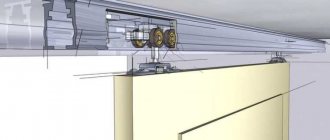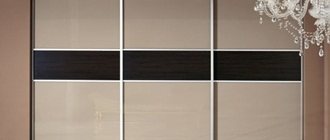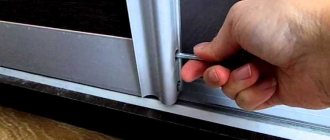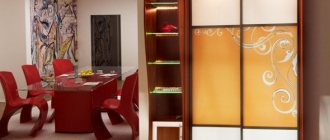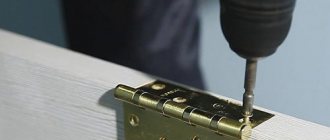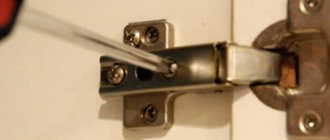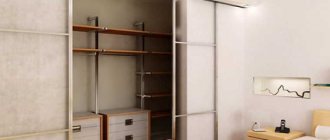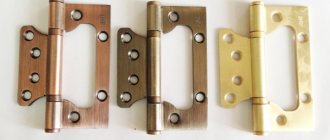How to choose a lock for a sliding wardrobe
In the modern world, anyone can afford to buy a wardrobe. The only difference in the products is the quality of the material from which it is made. You can order it from a good craftsman who will make, in your opinion, an individual sketch and take into account all your wishes.
To choose a lock and not make a mistake with your choice, you need to pay attention to the details.
In the modern world, anyone can afford to buy a wardrobe.
Every closet has doors that must be closed, so there must be a lock.
You can order it from a good craftsman who will make, in your opinion, an individual sketch and take into account all your wishes.
What material of the wardrobe will the product be attached to, since it may simply not fit during installation.
Those who have small children face the problem of clutter, because children love to play. A closet lock helps solve this problem by locking the doors in the open and closed positions.
Every closet has doors that must be closed, so there must be a lock.
Determine the required size of the lock so that it does not turn out to be larger or smaller than what was actually needed.
- half embedded;
- fully built-in.
Those who have small children face the problem of clutter, because children love to play.
Do not forget to pay attention to the mechanism - it can be different (the tubular locking mechanism is considered the most reliable).
- big and small;
- complex and simple;
- have a wide variety of colors (gold, copper, matte nickel, bronze).
A closet lock helps solve this problem by locking the doors in the open and closed positions.
For those who do not like locks with a key, it is better to opt for coded locking mechanisms, it is quite practical.
The advantage of any lock is that it should perfectly cope with its intended function. Any installation does not take much time, and with high-quality production it can last a long time.
The advantage of any lock is that it should perfectly cope with its intended function.
There is almost no difference in price category
The disadvantage may be poor-quality production and short-term operation due to unexpected breakdown. This causes inconvenience in future use.
Any installation does not take much time, and with high-quality production it can last a long time.
Before you decide to buy a lock for a sliding wardrobe, you need to study all the characteristics and, if possible, check the mechanism.
This causes inconvenience in future use.
Purpose and features
Furniture locks belong to the group of detachable fastening fittings, which also includes door handles, clamps, latches, hooks and latches. According to the structure of the mechanism, they are divided into certain categories. The design of the device depends on the material it is made of. Due to the fact that furniture locks are designed for a certain thickness of material, where the installation takes place, their structure will differ.
Furniture locks are used on cabinet doors, drawers, wooden safes, bedside tables, wall cabinets and other parts of furniture items. To understand what the products are intended for, you should consider their features:
- Material of manufacture - furniture locks are mainly made of durable materials - steel, aluminum, metal alloys. If it is made from a less practical material, such as plastic, the feasibility of its use is reduced. The best are metal options that will reliably hide the necessary items;
- Fastening area – depending on the material where the lock will be installed, many of its characteristics change. For example, the option for installation on glass will have a thickness less than its counterpart, which is intended for furniture made of laminated chipboard. This indicator should be taken into account when choosing a device;
- Mechanism - according to the principle of operation, there are push-button, rack and pinion, rotary and retractable. Each of these types of furniture locks for cabinets is used for specific purposes;
- Type of lock - there is a mortise lock, which is built into the surface of the facade, as well as overhead options. The latter are much easier to install: you don’t need to call a specialist to attach them, because everything can be done yourself;
- Reliability – modern manufacturers of furniture fittings have taken care to ensure the reliability of locking mechanisms. Mechanical options are gradually losing popularity, they are being replaced by innovative analogues: magnetic, electronic and code options. They provide an increased level of reliability;
- Size – according to the dimensions of the cabinet or other furniture, locks can be selected according to the size.
The main purpose of locks is to ensure secure storage of documents and other valuables. Another functional purpose is to close doors that are constantly opening.
How to choose?
It may be necessary to choose a lock for a sliding wardrobe for various reasons: either it is broken, or the product is simply not suitable for the sliding wardrobe, or when purchasing a cabinet, a defective one was found in the kit.
The disadvantage may be poor-quality production and short-term operation due to unexpected breakdown.
A closet lock helps solve this problem by locking the doors in the open and closed positions.
To choose a lock and not make a mistake with your choice, you need to pay attention to the following details.
- What material of the wardrobe will the product be attached to, since it may simply not fit during installation.
- Determine the required size of the lock so that it does not turn out to be larger or smaller than what was actually needed.
- Do not forget to pay attention to the mechanism - it can be different (the tubular locking mechanism is considered the most reliable).
This will cause inconvenience during further use.
The advantage of any lock is that it should perfectly cope with its intended function.
Every closet has doors that must be closed, so there must be a lock.
For those who do not like locks with a key, it is better to opt for coded locking mechanisms, it is quite practical.
You can order it from a good craftsman who will make, in your opinion, an individual sketch and take into account all your wishes.
Choosing a lock for a wardrobe can be necessary for various reasons.
Those who have small children face the problem of clutter, because children love to play.
There is almost no difference in price category. Before you decide to buy a lock for a sliding wardrobe , you need to study all the characteristics and, if possible, check the mechanism.
Either it is broken, or the product is simply not suitable for the compartment, or when purchasing the cabinet, a defective one was included in the kit.
Every closet has doors that must be closed, so there must be a lock.
Installation Tips
If you know how to work with furniture and power tools, then you will not encounter any obstacles to the correct installation of any type of lock.
Do not forget that locking device kits are always supplied with everything necessary, including detailed installation instructions. It is from this that I advise you to start first. But don’t forget about the general recommendations.
The principle of installing locks on different types of cabinet doors is identical. Therefore, the elements are mounted on the coupe in exactly the same way as on the same swing doors.
To clarify some things, let’s look at the main nuances of installing two types of protective and blocking structures.
Mortise locks
To work, you will need to prepare a drill, marking tools, a screwdriver or a screwdriver.
The process involves performing several sequential actions:
- First, carefully and as accurately as possible, apply markings to install the locking mechanism and the block where the latch will fit;
- It is recommended to install locking mechanisms approximately 2/3 of the distance from the floor level so that children cannot reach it;
- Using a drill with a special cutter, a hole is drilled for the lock body;
- The main lock block is installed on the sash with which the body of your sliding wardrobe will be connected. And an additional compartment is mounted on the facade;
- Fixation is carried out with self-tapping screws, a screwdriver or a screwdriver;
- The elements fit together. The levels match is checked. If it is not installed level enough, problems will arise during further operation.
I recommend checking the functionality of the lock itself before purchasing it. Make sure the key turns, the magnet engages, or the system responds to the entered unlock code.
Rim locks
Here the installation principle is slightly different. But there is nothing complicated about the DIY installation operation.
The following steps should be performed sequentially:
- Markings are applied to the door for installation of the main unit;
- holes are made for fastening the element;
- the main part of the lock is fixed using the fasteners included in the kit;
- markings are applied on the body with a marker;
- holes are made for the counter plate;
- a strike plate is attached under the main lock;
- the position and operation of the mechanism is adjusted.
If you use a magnetic lock, then installation is even easier. You just need to secure the mechanism to the selected area of the wardrobe. No need to drill mounting holes.
At this point, the procedures for installing locks for a sliding wardrobe can be considered complete.
Be sure to read the manufacturer's instructions first. Different systems may use special installation schemes that differ from competitors. That is, there are virtually no universal instructions for any type of furniture locking mechanism.
Does your wardrobe have a lock and why do you use it? Have you ever encountered the need to install locking mechanisms on furniture yourself? Share your own experiences, secrets and tips.
Thanks to everyone who reads us! Be sure to subscribe to notifications about new materials, leave your feedback and ask relevant questions!
What do you need to know when choosing a lock for a sliding door and when installing it?
When planning to install sliding doors, most people think about the size and design of the door, and not about the locks or handles. Many people believe that locks for sliding doors are not provided in principle. If desired, you can install a lock on sliding doors. You just need to decide which design will be most acceptable from the point of view of installation and subsequent operation.
Execution option
What types of locks are there?
These products are divided among themselves according to several characteristics. Locks are divided according to the principle of operation, the type of installation, as well as the location of the product.
If we talk about the principle of operation of locking devices, we distinguish between mechanical systems and electromechanical ones.
The device of a simple mechanical lock
The modern market offers many types of locks for sliding doors. Let's start with the simplest product. So, in such locking mechanisms, instead of the usual bolt, a special hook is used. It comes out of the lock body and falls into a special hole on the second part. It can be located on the door frame or on the second door leaf.
Since the coupling between the bolt and the counterpart of the lock is quite rigid, it will not open without a special key if it is locked with a similar lock for sliding doors. The key, in turn, may look like a pin or like a cylinder with jagged edges cut into it.
The simplest mechanical device must be equipped with additional elements. Thus, the kit includes a special bar equipped with a rotary handle. This strip will be recessed into the canvas during installation.
The specificity of this lock bar for a sliding door is in the “lamb” shape, which is pressed against the bar and does not interfere with the movement of the door leaf along the guides. In order to use the lock, the “lamb” is bent and the handle is turned to the side. If the door is not locked at this moment, then you can easily open it.
Also, a lock for a sliding door must be equipped with a bar on which the response mechanism is installed. For a single leaf door it is installed on the door frame. If the door is double-leaf, the strip cuts into the cavity of the second leaf.
Also, any product, even the simplest one, includes a secret mechanism with a hook and a keyhole.
The choice of mechanical accessories for doors of this type is quite wide. Without much difficulty, you can choose the one that suits you in terms of design, color, and operating principle. The operating principle of mechanical locks is practically the same. Different models from different price categories use similar mechanisms. These sliding door locks are quite reliable and durable.
How does an electromagnetic lock work?
These devices are based on a powerful electromagnet. By pressing the button, the voltage on the lock is turned off, the magnetic field no longer operates and the bolt snaps off. These devices are good for everyone, but among the disadvantages are the cost, as well as the inability to work without electricity.
An electromagnetic lock for a sliding door is not very popular as a locking device in apartments. But in non-residential premises they are installed and used. You can often find such systems on doors in offices and warehouses.
Glass door panels can also be equipped with these accessories. Among the advantages are simple installation without the need to make holes in the glass and the high durability of this design. Even in the largest offices, where doors are opened hundreds of times every day, these products will work for many years.
Electromechanical mechanism
These sliding door locks have a slightly different operating principle. But, like electromagnetic ones, they need electricity. The system is controlled using a remote control.
People willingly install such models on interior doors and partitions, but only if they can find fairly rare compact products on sale. Installation of such a locking device can be done on door leaves of absolutely any type, and even on glass ones.
Among the advantages, with proper use and timely maintenance, the system will work for many years.
Types of locking mechanisms
A vertical latching mechanism is installed on sliding sashes. When choosing a lock, you should take into account the material from which the sash is made, as well as the design features of the system itself. Sometimes you can avoid installing a locking system, since it is part of the handle.
Related article: How to assemble a door handle with a spring
Harpoon
The constipation includes the mechanism itself and the strike plate. The lock can be purchased for a sliding door, in which the doors move towards the side walls. The locking mechanism is attached to the door leaf, and the strike plate is attached to the side. At the moment of locking, a harpoon-shaped tongue is placed in the hole of the bar, preventing the sash from moving.
Attention! This system is applicable for one-, two- and three-leaf systems. To do this, two locks are installed on the central leaf, and strike plates are installed on the side ones.
Button
An option acceptable for double-leaf models. When the push-button mechanism is closed, a special rod extends. It rests against the second door, preventing it from opening.
If the thickness of the door leaf is not enough to securely fix the rod, the push-button mechanism is inserted into a special profile. With this installation, the rod rests on the profile of the second sash. This option is often resorted to when it is necessary to fix a glass or mirror sheet. If the door has a wooden frame, you should take care of strengthening it in advance.
Button
Magnetic
If a mechanical device is not suitable for some reason, you should pay attention to magnetic models. Such locks are compact in size and therefore ideal for sliding systems with glass and mirror panels. A magnet secures the sash when the locking part comes into contact with the mating part. However, during operation, such a system can become demagnetized, which often limits its scope of use. At the same time, if the real weight of the door was taken into account when calculating the characteristics of the magnet, the lock can last quite a long time.
Glass door locks
Given the fragility of the door leaf material, the list of locking systems and handles suitable for glass doors is limited. Even the use of tempered or impact-resistant glass is not a guarantee that the integrity of the mounted sash will be ensured during the installation process.
Often a lock with a removable cylinder is installed. To do this, a special hole is drilled in the sash itself, designed to accommodate a removable cylinder. Installation work should be carried out extremely carefully so as not to damage the sash itself. A handle is inserted into the prepared hole, the position of which is fixed using a special bushing nut. When the handle is closed, the locking mechanism is activated and the door is locked in the desired position. When opening the door, you need to grab the special protrusions, which are used as a handle to remove the cylinder. After this, you can open the sash.
Option for glass door
If the doorway is wide enough and the strength characteristics of the profile used in the manufacture of the door are optimal, it is possible to install a push-button system. Installing such a lock allows you to do without drilling a hole in the glass sash.
An overhead system is also sometimes installed on glass sashes, which involves fixing the sash using a toothed strip. The second sash rests against the bar. To close the door, you need to put the locking part on the bar, which will prevent possible movement of the sash. To open the door system, the entire installed locking structure must be removed. This option is not widely used due to its large size.
Is a sidebar necessary?
This is an important aspect that needs to be given due attention. If you decide to order a furniture lock, then first of all you need to determine its type.
There are two main types of these products:
- Invoices. As the name suggests, these locks are placed on the back of a drawer or opening flap and secured with self-tapping screws. Their installation is quite simple and does not take much time and effort.
- Mortise. These locks are considered more aesthetically pleasing to use, since they are almost completely hidden from view, but their installation is a little more complicated.
You need to understand that mortise locks are installed in a functional hole - a mounting socket, which can be made in several ways. For example, you can attach a lock, outline its boundaries and measure the thickness, and then hollow out the seat using a chisel and hammer. If we are talking about a round furniture lock, then the hole for it can be drilled with a feather drill for wood.
When installing mortise locks, be extremely careful as there are several risks involved. For example, a feather drill should be immersed to a distance equal to the thickness of the structure of the lock itself. If the hole turns out to be deeper, the difference can be compensated by placing folded paper. However, if you are not careful, you can drill through the tree, which will lead to a lot of problems.
In addition, correct marking is extremely important. If you are installing rim locks, then if the position is incorrect, you can unscrew it and reinstall it. In the case of mortise locks, you need to make the correct markings and drill the mounting holes so that you don’t have to make a new hole next to or to the side.
Drilling
Note that to install rim locks you will also need to drill a hole in the sash or drawer. It should be through, which will help insert the cylinder and bring the keyhole out. Rough edges are hidden using a decorative outer ring, but when drilling you need to be very careful not to damage the array.
To do this, it is recommended to use a simple technique:
- make markings and determine exactly where the lock will be located;
- mark the center of the larva and make a cross mark on the box or sash, pushing through the cross with an awl or the sharp end of a self-tapping screw;
- using a drill with a crown, carefully drill the array exactly halfway (hold the drill straight so that it does not move from side to side);
- then drill the remaining part from the back.
In this case, you can avoid the ragged edges that inevitably form when the crown comes out. This simple tip will help minimize damage to the array and make a neat through hole.
Please note that the diameter of the feather drill should be only 1 mm larger than the diameter of the central cylinder. In this case, the mechanism will sit tightly in the hole and backlash can be avoided.
Choosing a pen?
For the sliding system, you can choose a handle that will have the most suitable design. All existing varieties differ from each other in individual details, and therefore which option ultimately turns out to be acceptable will depend on:
- Design features of the door;
- Doorway size;
- Dimensions of the door leaf;
- Sash material;
- Personal preference.
All handles are mortise, and their handle is most often an ordinary recess used to open the sash.
Independent models
These handles got their name because they are not connected to any locking mechanism. Their design does not imply the installation of any kind of lock or elementary latch. If it is necessary to fix the sash in the closed position, to the leaf and side wall. The force generated must be sufficient to prevent the closed sash from moving.
Attention! If the door installation was carried out according to all the rules, you can safely refuse such a handle.
The popularity of independent handles is due to their:
- Fairly simple design;
- Low cost;
- Easy to install.
Most often these are mortise products placed inside the sash during installation. The handle does not extend beyond the door leaf, which makes it possible to open/close the door even with limited surrounding space. This model is suitable for cassette sliding systems, which can be completely hidden in the wall during the opening process. The installed handle in this case greatly facilitates the process of operating the door system.
Mortise with latch
This handle is initially equipped with a locking mechanism that allows you to open and close the latch when the need arises. In terms of their design, such handles are similar to models installed on swing doors, but they have some differences.
Firstly, the handle is made much smaller. Secondly, the latch comes out of the hole in the strike plate after turning a small handle or moving the slider. Both options assume that the parts used to open the door are located in a special recess on the door handle. As a result, the installation of such a handle is possible on doors that are used in limited conditions, for example, on cassette doors.
Handle with lock
This model differs from previous versions by the presence of a special hole designed to accommodate a keyhole. Manufacturers offer models that already have a cylinder of a locking design built into the handle, adapted to the operating features of the sliding door.
Related article: How to properly install a door in a wooden house
How to install a sliding door mechanism
You can also try to do all the work yourself. Here are some useful tips:
- Use well-sharpened chisels and drills to select the grooves for the handles and the niche for the lock body.
- Hold the drill strictly perpendicular to the surface, avoiding the drill from wandering.
- To ensure that the edges of the samples are even, make a cut along the marking line with a sharp blade.
- Before tightening the screws, make a drill with a diameter of 1.5-2 mm.
- Do not peel off the films protecting the decorative coating until installation is complete.
If you are not sure that you can do everything carefully, it is better to call a specialist, but be sure to be qualified to work with doors and have the appropriate skills and modern tools. When turning to non-professionals, you can get unpleasant consequences:
- If mistakes are made, the lock may become skewed, or the decorative coating of the door will be damaged. Also, often after installation the latch does not line up with the hole in the strike plate.
- Most private locksmiths do not have suitable locks and fittings at their disposal, which means you will have to spend your own time purchasing them.
- A casual worker may simply not be able to cope with the installation: the mechanisms for sliding doors are very compact and quite cleverly designed.
You can always count on the help of LOCKSERVISE specialists; we will quickly arrive and promptly install locks of any complexity.
If you need to install a lock on your sliding door, contact us right away!
Handle installation features
You can do the installation work yourself if you wish. The main thing is to have the desire and the appropriate tool to cut out the landing groove. You will have to tinker a little with the glass shutter, but you can install the handle on the wooden one as follows:
- Marking in progress. At this stage, the location of the handle is determined. To do this, the installed handle is placed in the desired place and outlined with a pencil. As a rule, a distance of about 0.9 m from the floor surface. You should also decide at what distance from the edge of the sash the handle will be located;
- Cutting a hole along the handle. To do this, a hole of the required shape and size is cut in the sash. To work, you will need a jigsaw or a hand router. If the sash is framed, the work should be done in the place where the timber is wider. This place is usually marked by the manufacturer, which should be taken into account when applying markings. Installation in another place can cause serious difficulties, since it will be very difficult to fix the handle in a hollow structure;
- Insertion of the constipation, if provided. If the lock is an integral part of the handle, you can immediately proceed to the next step. To do this, select a groove using the same router;
- The handle is installed. If you plan to install a lock, install it first, and only after that the handle. To do this, take one half and connect it to elements of ties that have internal threads. The assembled structure is inserted into the groove of the door leaf and fixed on the other side using a special fastener screwed into the tie.
System marking
Thus, a sliding door lock can have different designs. When choosing a lock, you should focus on the installation location, as well as which handle will be installed. Handles may vary in design and installation features. If desired, the sliding door can initially be equipped with a handle with a lock, which will greatly facilitate the installation process. When starting installation work, you should familiarize yourself with their features in advance in order to avoid possible errors that could affect the service life of the installed structure and its appearance.
How to install it yourself
Installing a furniture lock will be quite feasible for most users. The greatest difficulty is the installation of a mortise structure. Procedure:
- The necessary tools are being prepared. You will need an electric drill, a Forstner drill or a pen drill (the first is better), a ruler, an awl, and a screwdriver.
- Marking is being done. Usually a diagram is attached to the lock, which is placed on the door and the centers of all holes are marked. If there is no diagram, you need to accurately determine the dimensions and mark the drilling points on the sash. They are marked with an awl to leave indentations for centering the tool.
- The necessary holes are made. As a rule, you need a through one for the mechanism and several blind ones for fasteners, although there may be other options.
- The lock is fixed, a decorative ring is put on the cylinder.
- Next, focusing on the position of the part, the installation location of the counter structure is noted. It is attached to a fixed part of a cabinet or table.
Types of accessories for upholstered furniture, functionality and characteristics
The last step will be to check the functionality of the product and adjust the response bracket, if necessary. As a rule, you need to slightly bend the corner to achieve the desired result. After this, the installation is considered complete, and normal operation of the lock begins.
Tools are being prepared
Marking is being done
Holes are drilled
The lock is fixed
A counter structure is being installed
Selecting and installing a lock for a sliding wardrobe
The closet lock must perform a locking function and serve reliably for many years. Installation of the mechanism is quite simple and does not require special skills.
Today everyone can afford a wardrobe. It is compact, roomy and convenient. Regardless of whether you purchase a finished product, make it to order, or make it yourself, you should decide in advance whether you will need a lock for the sliding wardrobe. Most often, families with small children or owners of office premises think about locks.
Installing a furniture lock on wooden doors
To install locking mechanisms, you must have basic carpentry skills and a set of special tools. Installing a furniture lock involves four stages. The most difficult and responsible are the first two, namely marking the installation site and drilling it. At the last stages, the mechanism itself and the strike plate are fastened.
The marking is carried out taking into account the width of the square body, the diameter and length of the lock cylinder. To calculate the drilling center you need to perform simple mathematical operations. Having added to the radius of the cylinder the distance from the edge of the cylinder to the edge of the extended locking tongue, you should add a couple more millimeters to this amount. The resulting distance must be set back from the edge of the drawer or door at the location where the locking mechanism is installed. If the lock is installed on an external door, then it is necessary to add the thickness of the wall towards which it closes.
Then, taking an awl, you need to make a small indentation on the front side of the drilling center. This will improve the quality of drill alignment. To avoid possible chipping of the material, it is advisable to attach a small wooden pad to the back of the door. It is recommended to drill at low speeds.
A lock is inserted into the resulting hole, after which the places where the screws are screwed in using a screwdriver or screwdriver are marked with an awl. After this, you can begin installing the counter corner.
Types of locks, features of choice
The cabinet lock securely locks the doors in the closed position. There are several types of devices:
Also, locks vary significantly in size, material of manufacture, and complexity of execution.
The lock mechanism can be either simple or complex:
- A simple one resembles an ordinary hinge that holds a door.
- The complex mechanism is equipped with a key, which is reliable protection, or even a code system.
Choosing a lock for a sliding wardrobe is not difficult. Initially, you need to decide on the reason why the owner decided to purchase a new mechanism: the presence of children (pets), protection against burglary, breakdown of the old lock, door fixation.
- The size of the mechanism must correspond to the size of the wardrobe.
- The material used to make the cabinet is important, because sometimes it is simply impossible to install a lock. The thickness of the door leaf plays a huge role.
- The cost of complex systems is low, so it is better to choose a reliable mechanism.
- If the cabinet has two doors, one lock is installed; for a three-door cabinet, you need to purchase two mechanisms.
An example of a do-it-yourself wardrobe lock:
Among mechanical systems, the most reliable is the tubular shut-off system. When you come to the store, you need to carefully examine the products of various manufacturers and check what you like. The variety of models allows you to choose a fitting option that will not only secure the doors, but also look impressive.
Product Features
Furniture locks are included in the basic package of many sets and are installed at the factory during the assembly process. The traditional design is a conventional locking mechanism equipped with a tongue, a key and other necessary elements. The main purpose of the part is to keep the doors tightly closed. If necessary, you can install this element on finished furniture, where the presence of locks was not originally designed.
The main feature that furniture locks have is their size. Compared to conventional designs, they are reduced several times. This allows for hidden installation and maximum hiding of locking mechanisms.
Furniture locks are used on various items, doors or drawer linings. The following designs exist:
- Button lock. Used for sliding wardrobe doors. To close it, you need to press the lock cylinder (or lock cylinder). Unlocks with a key - 2 pieces included.
- Rack and pinion. Used for fixing glass sliding sashes. This group also includes a latch version, which is installed on hinged doors in a horizontal position.
- With latch. Its design is closest to conventional locking mechanisms. Used for installation on hinged doors of cabinets or on drawer linings. Locks itself, opens with a key (2 pieces included).
- Overlay for glass sashes. There are models for single and double door cabinets.
Purpose of furniture corners, advice on selection, installation rules
Button lock
Rack and pinion
With latch
Invoice
Different materials are used for production:
- steel;
- aluminum;
- metal alloys;
- plastic.
The most preferred are steel devices, which are durable and reliable. Depending on the type of finish, there are gold, silver, and blackened products. The selection of a suitable model is carried out taking into account the type of design of the element and the design style of the headset. A lock in furniture should not only fulfill its direct tasks, but also provide decorative design, decorate the doors or linings of various products.
Steel
Aluminum
Metal alloys
Plastic
Installation options
Initially, you need to determine what material the doors are made of:
This is very important, because the installation process depends on the material. Let's look at the most common installation options:
- Full mortise is suitable for doors with glass and chipboard.
- The lock escutcheon is ideal for doors made of glass and with mirrors.
- Partial insertion is used for cabinets made of laminated chipboard.
There are more complex models on sale: magnetic, electromagnetic. They are not recommended to be installed on cabinet doors, since during installation the weight of the structure is also calculated, which is difficult to implement at home.
Types of mechanisms and methods of fastening
Furniture production today distinguishes several types of fastening locks, on which the operation of the entire mechanism will depend. These are overhead and mortise options built into the surface of a furniture product. We should also highlight the padlock: although it does not look very attractive on furniture, it still provides a good level of reliability and security. To fully understand the picture of choosing furniture locks, it is recommended to consider the operating features of the mechanisms and installation methods:
- Mortise furniture locks - this option is considered reliable; it also does not impair the appearance of the furniture product and provides quick access to the contents of a drawer or cabinet. The mortise type today is divided into the following types of mechanisms: cross-shaped, cylinder, lever. Cross-shaped designs are based on the use of a cylindrical mechanism; they have several code pins arranged in a row. The turnkey well is made in the shape of a cross. The reliability of this type of mortise furniture lock is low. Cylindrical mechanisms today have several types of cuts: finger-type, telescopic, snake-shaped. Their body can withstand almost any damage. The lever lock consists of several plates moving in the formed groove. They are easy to replace and have a high-quality secret;
- Overhead furniture locks are easy to install; even a beginner can install them. Options can be mounted on doors and drawers made of chipboard, glass, and also installed on double doors. According to the mechanism, they are divided into: retractable – for tables, chests of drawers and drawers; locks with a twist mechanism are good for cabinets with several drawers. rack and pinion mechanisms that fit onto a bar with teeth; harpoon-shaped, used for sliding doors; keyless locks with built-in latch button.
The latest version of the overhead furniture lock has proven itself in use on glass. Locks with a retractable mechanism are often used for glass doors. They have an elongated body and a rotary opening system. Also for glass, a rack and pinion mechanism is widely used, which is installed using toothed strips.
Mortise
Invoices
Installation process
Let's consider the process of inserting a standard lock with a key, consisting of the following elements:
- Tubular core (varies in diameter).
- Overlay strip (plastic or metal).
- Response plate.
To work, you need a minimum of tools: drill, screwdriver, forstner cutter of suitable diameter (not always required), screwdriver, screws, pencil. If the lock is semi-mortise, then you need to drill a hole under the core using a cutter of the required diameter. For overhead mechanisms, all the work comes down to drilling thin holes for self-tapping screws. There may be two or four.
Initially, the location of the lock is determined. The center of the door is ideal for this. Using a pencil makes marks easy. Now the preparatory work is done: holes are drilled.
Related article: How to saw a door frame at 45 degrees
After the lock is secured, a strike plate is attached to the second door. A little trick: close the doors, apply a strip and outline it with a pencil. Now it is easily attached to the canvas in the open position.
Speaking about furniture locks, we cannot help but recall that for glass and metal doors you will need to use the appropriate drills. If they are not available, consider the cost when purchasing the lock. In some cases, it is appropriate to call a specialist.
Finishing touch
The service life of a lock depends, first of all, on its quality: the better it is assembled, the stronger the material, the longer the lock will last. Good locks, in addition, should not change their color or fade, that is, they should have a high-quality coating.
Also, when purchasing a lock, you should pay attention to how smoothly the mechanism works, and most importantly, the key from one lock should not fit another. Manufacturers of quality locks have thousands of different combinations to avoid this situation.
You can familiarize yourself with all of the above lock models in more detail in the electronic catalog or at the MDM office, where professional managers will show you each model in action and choose the best option for you.
Come and choose “Locks worthy of your furniture”!
Assortment of locks for sliding doors
Doors can be metal, wood or even glass - it all depends on the personal preferences of the owner of the room, as well as on the overall design and design of the room.
Regardless of the material from which it is made, the model needs a locking mechanism (especially if it is an entrance). This element, intended only for sliding doors, differs significantly from similar devices that cut into ordinary doors.
To begin with, it should be noted that there are several classifications of locks.
They may differ in the following ways:
- principle of operation;
- installation method;
- location on the door leaf.
If we talk about the principle of operation of locks, there are several options.
- Mechanical. Such devices are closed and opened using a special latch using a key. It should be noted that these designs are widespread and quite popular due to their affordable price.
- Magnetic. The base in this model is a magnet. The main disadvantage of this option is the fact that it works exclusively in the presence of electricity (the fact is that the magnet begins to work only under the influence of electric current). Accordingly, if the power is turned off, you will not be able to open or close the door.
These devices are quite expensive.
Let's move on to a discussion of types of locks that differ in installation method.
- Invoices. Such mechanisms are installed on the surface of the door, as if overlapping (hence the name). These models are divided into mechanical and magnetic.
- Mortise. This type is considered more suitable for installation on sliding doors. The process of attaching them to the door is more complex and time-consuming, however, in the end you will get a safer and more reliable lock.
As for the location on the door leaf, the locks can be:
- lateral (standard);
- lower (floor).
Types of locks for sliding doors
There are various types of shutter mechanisms. They differ from each other in their method of operation, installation, cost, size and other characteristics. Locks for interior sliding structures can be equipped not only with a handle, but also with a special button.
Usually the door leaf is immediately supplied with all the fittings to specialized stores. But there may be a need to replace a failed device or purchase and install it if it was not included with the door itself. Therefore, you need to know what types of shutter mechanisms there are.
Types that are suitable for the sliding model:
- Permanent magnet mechanisms.
- Electromagnetic.
- Electromechanical.
The first option has a complex design. The principle of operation is to attract a magnet located in the lock body to the strike plate. The disadvantage of this mechanism is that it cannot be installed if the door leaf is thin.
Electromagnetic options are rarely installed on interior doors in apartments. But they are widespread in office spaces. They are mounted on glass models. To install electromagnetic devices, you do not need to make additional holes in the door leaf. The downside is that you will need to make electrical connections to the mechanism. The device can only operate if there is a constant power supply.
The third type is also rarely used as a shutter for interior doors in apartments. The fact is that such locks are large. Opening or closing can be controlled remotely. Their disadvantage is that they can only operate on electricity.
For interior sliding structures, a lock with permanent magnets is suitable if the thickness of the leaf allows installation of the mechanism. They do not use electricity to operate.
How to choose?
When choosing a lock for sliding doors, you must take into account the material from which the door is made. Thus, wooden fences are considered the most versatile - almost any lock can be installed on them. You need to be most careful with a glass door - they usually choose overhead magnetic locks.
You should keep in mind the overall design and interior design of the room. Locks should not play the role of accent elements; on the contrary, they must be made as inconspicuous as possible and “fit” into the interior as best as possible.
You need to pay attention to the comfort of opening doors.
To make this process as convenient as possible, mortise devices are usually chosen for sliding doors.

